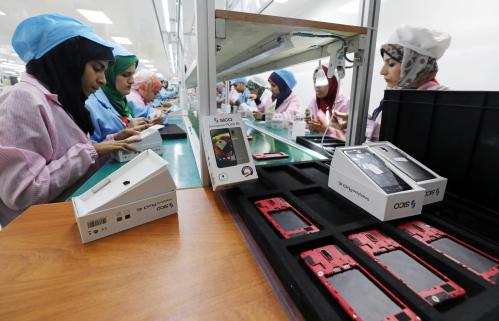Large, educated labour pools
have contributed to a bloated
public sector throughout the
Middle East and North Africa (MENA).
According to the Organisation for
Economic Cooperation & Development
(OECD), the World Bank (WB), and
the International Monetary Fund (IMF),
MENA public sectors employ between 14
per cent and 40 per cent of all workers
in the region. Historically, the public
sector served as a political solution to
the economic problem of unemployment.
Entrepreneurship programmes that
support small to medium enterprises
through financial and technical support
are one long-term solution for addressing
excess labor capacity, but they require
investment in the private sector and
can offer little in the short term.
Meanwhile, MENA fiscal budgetary
commitments have increased and public
sector employees are retiring, collecting
ever-dwindling pensions even as life
expectancies increase.
The future of the MENA region
requires a creative solution to transition
public sector employees into the private
sector in order to promote balanced
economic growth. The private sector
cannot create employment opportunities
in the short term without intermediary
forces – such as foreign investment,
regulatory reform, and skills development
– so a medium-term approach is needed
to draw down public sector employment.
We propose an approach known as ‘intrapreneurship,’ which has produced
continued gains for both the private
and public realms. Canada, the US,
and Egypt offer examples of successful
intrapreneurship examples.
What Is Intrapreneurship?
Intrapreneurship is characterised by
the ‘start up’ style of management,
characterised by flexibility, innovation,
and risk-taking. The objective is tocircumvent bureaucracy and fast-track
private sector development by harnessing
or taking advantage of new opportunities
and new processes or designs.
Intrapreneurs work from within an
institution, providing their expertise to
that institution rather than to an external
party. The success of Google, LinkedIn
and Dreamworks, for example, is due to
their ability to embrace intrapreneurship:
offering time and resources to employees
who demonstrate creativity and initiative.
Intrapreneurs can enhance efficiency
and productivity in large organisations
(Forbes, 2012). For instance, intrapreneurs
within the Sony Corporation worked to
produce sponsored search engines via
Yahoo, Scion17 free Internet radio, and,
most impressively, the Sony Playstation.
Many global non-profit hold contests
to invest in innovation and the talent
behind it. Emerging market economies,
like Brazil, are key competitors. However,
the 2012 Ashoka contest, co-sponsored
by the International Finance Corporation
(IFC), provides a telling example of the
need for Arab countries to enhance their
participation in intrapreneurial practices:
as of December 15, only one of 77 contest
entries were from the Arab world.
Both the U.S Department of Justice
(DOJ) and the U.S. Government
Accountability Office (GAO) promote a
culture of intrapreneurship within their
organisations. DOJ and GAO operate
“Employee Suggestion” programmes
whereby ideas that promote institutional
efficiency are recognised by the
organisations’ leadership. The GAO offers
mentoring programmes that give budding
intrapreneurs the opportunity to explore
ideas and receive critical feedback. The
increased dialogue created through shortterm
placements and online sessions
allows employees to enhance their skills
and knowledge base.
Intrapreneurs work from within an institution, providing their expertise to that institution rather than to an external party. The success of Google, LinkedIn and Dreamworks, for example, is due to their ability to embrace intrapreneurship: offering time and resources to employees who demonstrate creativity and initiative.
Intrapreneurship rewards both the
individual and the institution; even if employees enter the private sector,
the institution can claim success in
“spawning” new business entities.
Multiply this scenario across several
institutions over ten years and the result is
a generation that has contributed its talent
to both the public and private sector.
Intrapraneurship benefits the larger
organizational culture by increasing
employee satisfaction and productivity.
And once employees – including civil
servants – realise they can pursue ideas
within a supportive environment, they
often do so in innovative ways.
There are four key benefits to
facilitating intrapreneurship within the
MENA public sector:
Transition out of public service
Intrapreneurship provides a desirable
alternative for those in public service
who face early retirement. The
cost of investing in public-sector
intrapreneurship initiatives can offset
the cost of the benefits civil servants
collect upon retirement.
The end of entrepreneurship stigma
Jumpstarting entrepreneurship in MENA
is a challenge. There is a pronounced
stigma to being an entrepreneur in
the MENA region. In Egypt, “failed”
entrepreneurs can face criminal charges.
Also, much of the population is over
the age of forty and believes that it
has entered a stage of life in which it
is too late to assume entrepreneurial
risk. Finally, even if donor-supported
initiatives like Jordan’s ICT group
promote entrepreneurship, publicsector
employees are unlikely to leave
safeguarded jobs.
But the stigma against entrepreneurs
may not extend to intrapreneurs once
certain conditions are met. First,
given that many MENA countries are
also emerging market economies,
intrapreneurial programs must come
from within, so that institutions can
claim ownership of the program,
even with support from outside
partners. Shared ownership is key to
addressing the impression that these are
externally imposed reforms. Secondly,
the problem for intrapreneurs is that
their “enterprising” ideas may appear
to challenge public sector traditions
and achieve little traction. Therefore,
implementing an intrapreneurial
programme within institutions allows
participants to contribute without
managerial obstacles.
Promotes skills sharing at
universities
In 2012, Saudi Arabia ranked 12 out of
183 economies in the “Ease of Doing
Business Index”, achieved in part by
the country’s ability to harness the
entrepreneurial efforts of its Dhahran
Techno-Valley (DTV) effort. DTV operates
as a partnership between a university
and multi-national corporations to
develop offshore R & D centres: Within
five years, the partnership led to a
specialised technology sector hub where
employees innovate from within.
Intrapreneurship provides a desirable alternative for those in the public service who face early retirement. The cost of investing in public-sector intrapreneurship initiatives can offset the cost of the benefits civil servants collect upon retirement.
Skills sharing at universities can use
personnel structures already in place
for employees who wish to pursue
professional development opportunities.
Large personnel structures exist in many
MENA government offices – and have
overlapping job functions that allows
them time to engage in knowledge
transfer activities. Mid-level career U.S.
GAO employees have accumulated
specialised knowledge this way. Although
it may not qualify them for senior
management positions, they can use their
new-found expertise to serve as adjunct
faculty at universities.
Helps latent women and youth
into work
MENA’s public sector’s uptake of
intrapreneurship relates to two groups
that are crucial to increasing growth in
MENA economies: women and youth.
Women in Egypt and Tunisia attend
school longer than men, but are often
restricted from entering the formal
economy. Women make up 14 per cent
of Jordan’s workforce, among lowest
rates in the world, according to Minister
Reem Abu Hassan. Consequently, many
women disengage from the workforce
once they marry.
If women and youth in MENA are
not tapped as a potential resource,
countries like Oman – which has a
shortage of scientists and engineers –
will have to continue importing skilled
expatriate labour.
Unlocking Potential —
Intrepreneurship in
MENA
Intrapreneurs will be crucial to
modernising economies throughout
MENA.
In 2011, Ernst & Young Financial
Services partnered with Endeavor –
a global not-for-profit organisation –
to launch its Intrapreneur Programme.
The programme allows Ernst & Young’s
top-performing managers to carry out
six-week placements at companies
within their home countries – many
of which are emerging market
economies in the Middle East (Egypt,
Jordan, and Lebanon).
According to Endeavor Egypt
participant Amr Shady: “Participants in
the programme have a skill set that we –
as entrepreneurs in the Middle East –
don’t have. Their knowledge and
experience can help us navigate the
threats and risks we face each day,
while enabling us to pursue the growth
opportunities that will transform our
companies and countries.”
Indeed, when employees explore
inventive opportunities, they bring
fresh perspectives to business challenges.
For MENA, this approach is key to
mainstreaming entrepreneurial
practices, both in the public and
private sectors.
The Brookings Institution is committed to quality, independence, and impact.
We are supported by a diverse array of funders. In line with our values and policies, each Brookings publication represents the sole views of its author(s).









Commentary
Op-edIntrapreneurship in MENA’s Public Sector
August 21, 2013